First around the world
I.F. Krusenstern
This year marks two hundred and ten years since the start of the first round-the-world voyage of two Russian ships under the leadership of captain-lieutenants Ivan Fedorovich Kruzenshtern and Yuri Fedorovich Lisyansky. Their adventures abound with “white spots”, controversial incidents and intriguing events. Each historical The fact that sheds light on this expedition is of genuine interest to both experts and lovers of native history.
Starting a story about this voyage, it should be noted that the traditions of domestic long-distance sea travels take their countdown much earlier than the beginning of the nineteenth century. The idea to make a world tour originated in Russian minds back in 1732. In the autumn of this year, the senators decided on whether the expedition of Vitus Bering would reach the East by land or by sea. Summoned members of the Admiralty Board, including admirals N.F. Golovin and T.P. Sanders presented a well-thought-out project of a world tour. Golovin himself wanted to lead the voyage; he considered such an enterprise to be an excellent school - "... officers and sailors will learn more than one ten years at this sea in one such way." However, the senators, for unknown but obviously good reasons, did not obey eminent admirals and preferred the dry path. This decision condemned Bering to unimaginable difficulties in transporting thousands of pounds of equipment from the northern capital to Okhotsk, where the construction of ships was planned. Still, it was the forefront of the world tour.
The next serious attempt was much closer to implementation. In the year 1786, PP Soymonov (private secretary of Catherine II) sent to the Commerce Collegium "Note on animal crafts and bargaining on the Eastern Ocean." It contained fears for the Russian economy in America and suggested measures to protect the British from expansion. By the way, the leaders of the maritime and commercial departments have long thought about this issue. 22 December The decree of the Empress was issued on the 1786 of the year, ordering immediately to send two armed ships from the Baltic Sea. The most experienced sailor, Grigory Ivanovich Mulovsky (twenty-nine years old, by the way), was assigned to lead the expedition. The route was laid "meet the sun": the Baltic Sea - the southern tip of Africa - New Holland (Australia) - Russian lands in the New and Old World. But then the military conflict with Turkey began. The expedition was canceled, and the Mulovsky squadron was sent to fight in the Mediterranean. And soon the war broke out with Sweden. In the middle of the 1788 year, Mulovsky was appointed commander of the Mstislav. The same year, seventeen-year-old Vanya Kruzenshtern, who was released from the cadet corps, arrived ahead of time. It was to him that Mulowski ordered the Swedish admiral Lilienfield to pick up after the 36-gun "Mstislav" forced the 74-gun "Sophia-Magdalen" to surrender.
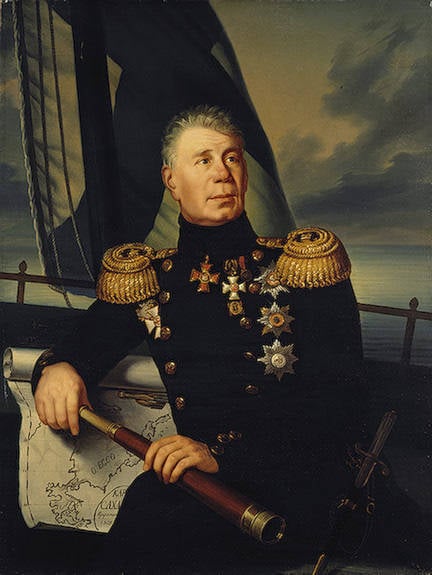
The history of the first domestic campaign "around the world" began in the 1799 year, when Ivan Fedorovich outlined in the naval ministry his views on the organization of such a voyage. The need for this was long overdue, the possessions of Russia in America needed a fast, regular supply of food and things that they had carried up to that moment through terrible roads all the way to Okhotsk. Equally difficult was the return journey for fur goods to China. According to Kruzenshtern's proposal, the expedition could prove the expediency of such voyages, as well as conduct numerous studies of the World Ocean and allow Russia to stand on a par with Great Britain, Spain, and France. The project was ignored for a long time, until a rich and influential Russian-American company turned to the emperor with a similar proposal.
In fairness, it should be noted that the development of the project of the round-the-world expedition does not belong to either cancer or Krusenstern. A huge number of people took part in it, including the Minister of Commerce, Count N.P. Rumyantsev, marine minister N.S. Mordvinov and a number of prominent scientists of the Academy of Sciences. In the summer of 1802, the project of the expedition received the highest approval, and direct preparation began for the march, which was to be headed by Ivan Krusenstern, who was approved for this post on August 7 of the same year. Curiously, but initially he refused to participate. The reason for this was a change in his personal life, the sailor got married and soon had to become a father. Only NS himself managed to convince him. Mordvinov, who announced that if the captain did not agree to fulfill his plans, the enterprise would not take place at all.
The bulk of the equipment for equipping the campaign was allocated by the leadership of the Russian-American company, the personnel of Ivan Fyodorovich chose himself and only among volunteers. He gave the second ship to Lisyansky, and identified his experienced and savvy officer, Makar Ratmanov, who became famous in the wars with the French and the Swedes as his assistant. It was decided to buy ships abroad. For this purpose, Lieutenant Lisyansky went to England. For seventeen thousand pounds, he acquired two old, but strong enough three-masted sloops “Thames” and “Leander”, which were later renamed “Neva” and “Nadezhda”.
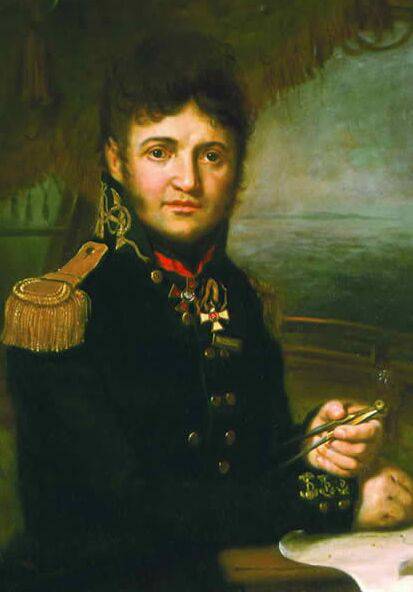
In February, the government of 1803 had the idea to send a diplomatic mission to Japan to establish trade relations. It was headed by Nikolai Petrovich Rezanov. The chamberlain and the actual State Counsel enjoyed the sympathy of influential persons of the state (in particular, GR Derzhavin), and also successfully married his daughter, G.I. Shelikhov. The materials related to his personality are extremely contradictory, however, undoubtedly, he was a very resourceful and vain man. Rezanov received numerous instructions from the board of the Cancer and the Ministry of Commerce, most of which were approved by the emperor. In many of these papers, he was considered the leader of the expedition. However, relations with Ivan Fedorovich were not registered anywhere, and on arriving at the ship the ambassador did not officially announce his powers. This is quite obvious, since it is unlikely that any of the military officers would sail under his superiors.
August 7 The Nadezhda and the Neva, driven by the wind, left Kronstadt raid on 1803. Having noted in Copenhagen and the English port of Falmouth, having safely survived the first storm, the ships stopped at the Spanish island of Tenerife.
As soon as the ships left Europe, that is, when Kruzenshtern had almost no chance of interrupting the expedition and returning, Rezanov, in private conversations, began to acquaint the officers with their instructions and powers. It was at this time that the first conflicts began between the captain and the ambassador, who had never before been at sea but tried to impose his will on Krusenstern. The letter, soon sent by Ivan Fedorovich to the Board of Cancer for explanations, is a good indication of the situation: "... being subordinate to Rezanov, I cannot be useful, but I do not want to be useless." Ratmanov also supported his commander, sending later to the entourage of the Minister of Naval Forces P.V. Chichagov wrote: “... I humbly ask me, as a senior naval officer, to save Mr. Rezanov from the authorities and together with Lieutenant Commander Krusenstern to return to Russia, because his actions with the captain for all noble souls are very disliked ...".
November 26 1803 of the Russian ships for the first time saluted our flag in the southern hemisphere. On ships on that day a holiday was arranged, sailor Pavel Kurganov played the role of Neptune, welcoming members of the expedition with the first appearance in the southern region. December 21, sailing the Atlantic Ocean, "Hope" and "Neva" anchored near the island of St. Catherine, fenced off by the strait from the Americas in the Brazil region. The magnificent tropical nature, the unusual appearance of the locals, the diversity of flora and fauna made a great impression on travelers from Russia. Ratmanov wrote in his diary: “... the view, the climate, the riches of the place are the best, there is abundance in everything here; and it is a pity that it does not belong to us ... ". Scientists made trips deep into the island and even to the mainland, collected herbariums, collections of animals, fish, and insects. Krusenstern personally supervised the majority of scientific works, taking part in research. The sailors replaced parts of the ship's rigging, and the officers did astronomical calculations, measured the depth of the waters, surveyed the terrain, and made nautical charts.
At this point, the disagreements between Ivan Fedorovich and Rezanov took an open form, living on the “Nadezhda”, they communicated only through correspondence. Nikolai Petrovich demanded submission from the leaders of the expedition, tried to control Lisyansky, but all his orders were ignored — there was no other and could not be expected from naval officers. After he declared the danger of sailing through Cape Horn and, having buried all the plans of the Around the World, demanded to go to Japan via the African coast, officers directly stated to Rezanov that they did not consider him the head of the expedition and would not carry out his orders. How the other faces of the crews behaved in this conflict is difficult to establish. However, the ambassador himself claims in his diaries that he was constantly being insulted and humiliated by all members of the Nadezhda team. Despite the fact that much of the messages Rezanov recognized as a lie, there are reviews of scientists (officially subordinate to him) about the existence of some problems associated with the personal qualities of Nikolai Petrovich.
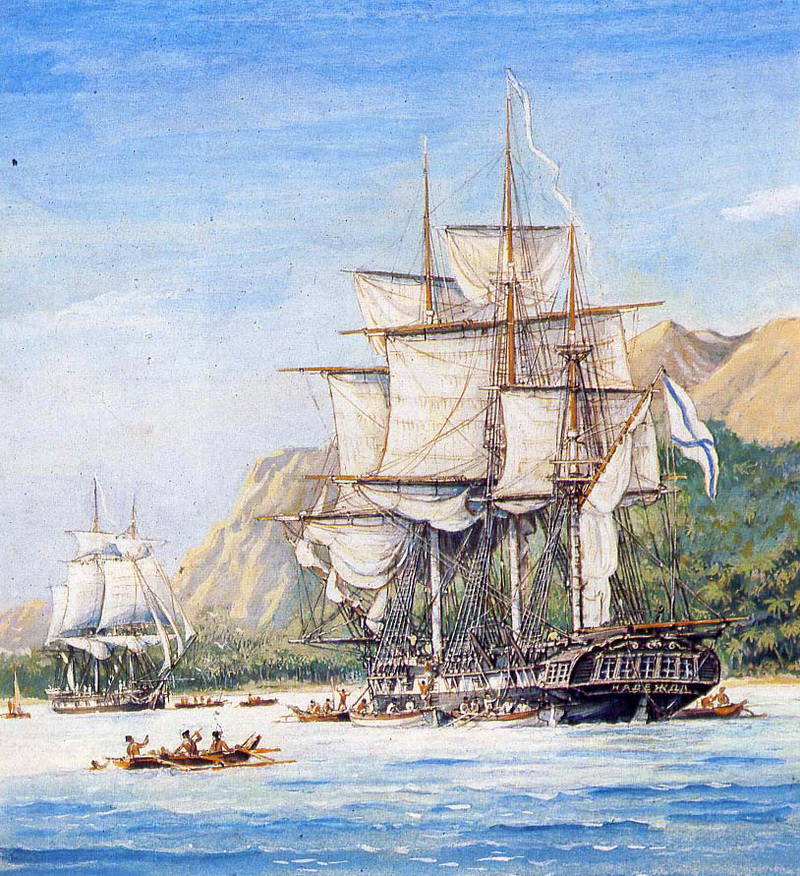
February 4 ships left the coast of Brazil, and 3 March 1804 th year passed Cape Horn and hit the Pacific Ocean. Soon in the descending thick fog the ships lost each other. “Neva”, as it was decided in advance, went to Easter Island, and “Nadezhda” sailed to the Marquesas Islands. Magnetic, meteorological and hydrological observations were constantly conducted on ships. The speed of the current was measured near Cape Horn, and while the Neva was located near Easter Island, Yury Lisyansky mapped her map and specified the coordinates.
In early May, Kruzenshtern led the ship to the island of Nukagiva. A couple of days later the Neva came here. These islands were a real promise for naturalists who collected interesting materials and collections of household items and weapons. Describing the locals, Makar Ivanovich wrote: "... the first time we saw tall and handsome, naked men, painted with great art." Here, Krusenstern announced a well-known order to the sailors: "We will leave the shore of this quiet people, without leaving a bad name for ourselves." Such respect for the traditions of others was strictly observed in all subsequent Russian expeditions.
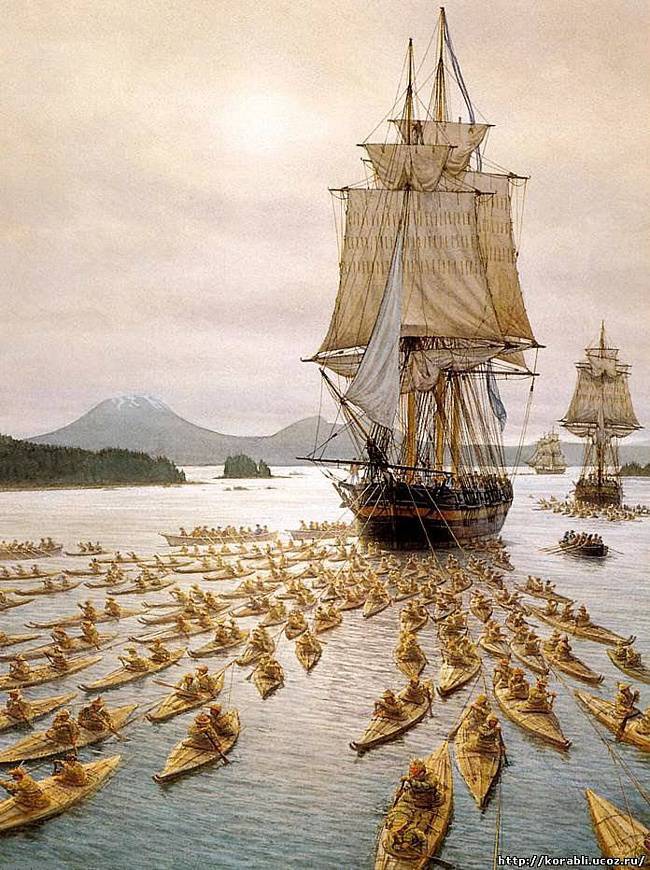
Since there was a shortage of food on ships that had been sailing for several months, Kruzenshtern forbidden to trade with the islanders without permission until the expedition was provided with fresh food. However, Nikolai Rezanov despised the order of the captain, provoking an incident that was the culmination of the whole conflict. Having personally received a ban on barter, Rezanov began to publicly curse Ivan Fedorovich on the broker. It should be noted that this place on the ship is considered special, any insults to the captain here are a terrible act. Krusenstern, first of all a combat naval officer, could not bear such a thing. After the scandal that had happened, Rezanov suddenly became seriously ill and did not leave his cabin until he arrived in Petropavlovsk.
In June 1804, the expedition reached the Hawaiian Islands. Here the ships had to part for a long time, the meeting was scheduled for November 1805 of the year in the Chinese port of Canton. According to the plan, “Nadezhda” passed the ocean to the south-east of the islands of Japan and dispelled the myth of the lands that existed in this place. Immediately upon arrival in Petropavlovsk, Nikolai Petrovich summoned Kamchatka commandant Pavel Koshelev and demanded that Kruzenshtern be tried. Cases of this kind were not the prerogative of the commandant, however, he had to somehow respond to the demands of the royal dignitary. Fortunately, the Major-General did not suffer from his rank of office and calmly conducted an investigation into the matter, having managed, in the end, to reconcile the conflicting parties.
Six weeks later, the Nadezhda left Petropavlovsk Harbor and went to Japan. On September 15, crew members celebrated the coronation day of Alexander I. On this occasion, Rezanov delivered a long speech and presented all members of the expedition with a medal. On one side of them, the emperor was depicted, on the other, the inscription: “The law is a pledge of the bliss of everyone.” And on the eastern shores of the country of the Rising Sun, a cruel typhoon seized a ship. Krusenstern, noting the fearlessness and courage of the sailors, wrote in his diary: "... you must have the gift of the poet, in order to describe the rage thereof."
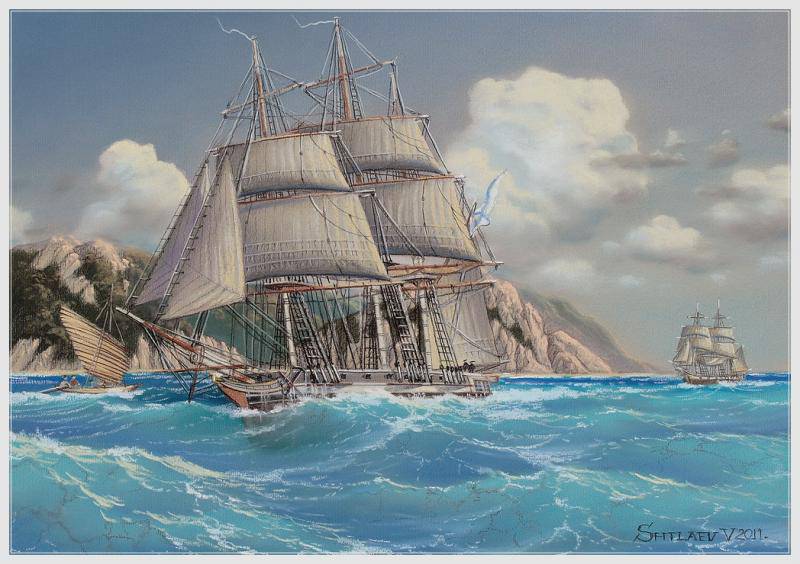
8 October 1804 of the year the ship anchored in the port of Nagasaki. Immediately, local officials and a Dutch diplomat arrived on board. First of all, the Japanese demanded to give them all the weapons available on the ship. Then the Russians were forbidden to go ashore and swim across the bay. These measures were explained by the law in force in the country since 1638, prohibiting foreigners in the country "until the sun illuminates the world." Being a completely closed state, Japan did not have any contact with the outside world, all attempts by the Europeans to establish them were in vain. Only the Dutch managed to establish a small trade. In 1793, the Russian expedition of Adam Laxman was able to convince the Japanese government to make some concessions, in particular, one Russian ship was allowed to go to Nagasaki harbor. Eastern trade attracted Russia, the maritime ministry wanted to make it possible for our ships to go to all ports of Japan, so Rezanov was to develop Laxman’s achievements. However, his mission suffered a complete fiasco. For six months, the ambassador lived in a small area of the Japanese coast, surrounded by a fence, then the Japanese refused to talk, returned the gifts of the Russian emperor and handed Nikolai Petrovich a paper banning the approach of the Russian courts to the shores of their country. Ratmanov described the “diplomacy” of the Russian dignitary as follows: “... the farces of Mr. Chamberlain Rezanov did something that we lost the rights that Laxman had obtained.”
In the port of Nagasaki, “Nadezhda” stood until mid-April, 1805. And although Rezanova’s mission failed, the departure of the Russian ship was accompanied by hundreds of ordinary Japanese in small boats. Back to Kamchatka, Kruzenshtern returned a completely unknown earlier course, along the western shores of Japan, making a description of Tsushima Island along the way. Today, this part of the Korea Strait is called the Krusenstern Pass. Then the navigators studied the southern part of Sakhalin and the strait, now bearing the name of the captain, crossed the ridge of the Kuril Islands, where they almost died in the rocks.
In Petropavlovsk, the expedition left Rezanov, going to Russian America. Ratmanov wrote about this: “The ambassador wanted to go to Petersburg, but after receiving the dispatches, he changed his intention, which is not new for us, and we already made a big habit. 13 June he went to Kodiak, saying goodbye to us. I don’t think that any of us will put on mourning about this separation. ”
The time remaining before the meeting with the Neva, Ivan Fedorovich devoted to the study of Sakhalin, which since the time of swimming La Perouse was considered a peninsula. He did not have quite a bit of time and luck to find the mouth of the Amur and restore the truth. From Petropavlovsk "Nadezhda", loaded with furs for sale, went to China.
No less interesting were the adventures of the Neva. When the Nadezhda sailed forward, the crew continued to study the flora and fauna of the Hawaiian Islands. Locals received guests from a distant country quite friendly. Even in the village of Tavaroa, nothing reminded of the tragedy of twenty-five years ago when Cook was killed. Thanks to the help of the islanders, the ship's ethnographic collections were replenished with unique samples of local clothing and utensils.
A few weeks later Lisyansky led the ship to the settlement of Pavlovsky in the territory of Alaska. The Russian inhabitants of Kodiak Island enthusiastically greeted travelers who had traveled such a long and difficult journey. At the request of representatives of the Russian-American Company in August 1804, naval sailors took part in the liberation of the inhabitants of Arkhangelsk fort located on Sith Island. They were captured by Tlingit (Indians from the southeast of Alaska), commanded by American sailors.
More than a year, the Neva was standing off the coast of Alaska. Lisyansky, together with his assistants, drew maps of countless islands, conducted astro and meteorological observations, and compiled a brief dictionary of languages of northwestern America. In September, 1805, having loaded the ship with furs from Russian crafts, Yury Fedorovich sent him to the shores of China. Three months it took the sailors to go, strong hurricanes and fogs slowed down. In stormy conditions, the Neva stranded near an island unknown to the mariners, and only thanks to the selfless actions of the sailors did the ship manage to be saved. The island at the insistence of the team was named after Lisyansky. And on the very shred of sushi they placed a pole under which they buried a bottle with a piece of paper containing all the information about the discovery.
4 December 1805 of the year the team "Neva" saw the familiar silhouette of "Hope". Having sold furs and loaded with Chinese goods, the ships crossed the South China Sea and sailed through the Sunda Strait into the Indian Ocean. They had to go around Africa and return home to Russia. 15 April 1806 of the year the court crossed the meridian of the Russian capital, completing a circuit of the globe.
The return voyage was fairly safe and conflict-free, although it was clouded by the unexpected suicide of the second lieutenant of the Nadezhda, Peter Golovachev. The circumstances that pushed the officer to such an act are vague, but one cannot discount the accumulated enormous fatigue and nervous exhaustion of the members of the expedition. This is clearly seen in the latest diaries of Ratmanov, which are becoming more and more incoherent.
The ships parted near the Cape of Good Hope, and until their return to Kronstadt, their voyage took place separately. On St. Helena, Kruzenshtern learned about the outbreak of war with France. Fearing enemy ships, he traveled to his homeland bypassing the British Isles with a stop in Copenhagen. 19 August 1806 year, that is, after three years and twelve days, "Hope" anchored in the port of Kronstadt, where it was already waiting for two weeks, "Neva".
Lisyansky, having carefully checked the stocks of food and water, ventured to make a non-stop voyage to England. He said “... such an enterprise will bring us great honor; not a single mariner has ventured so far, without stopping anywhere for repose. ” The distance from Canton to Portsmouth (13 923 miles) the ship passed a hundred and forty days.
Upon arrival, both ships were visited by Alexander I, and on August 27, the emperor at the residence on Kamenny Island accepted Ivan Fyodorovich, awarding him with the Order of St. Vladimir. The journey of Krusenstern and Lisyansky was recognized as a scientific and geographical feat. In honor of this event, a medal was knocked out: “For a journey around the globe 1803-1806”. The results of the expedition were collected in the geographical works of the captains, as well as natural scientists V.G. Tilesius, I.K. Horner, G.I. Langsdorf and other participants.
Information sources:
http://www.prlib.ru/history/pages/item.aspx?itemid=1084
http://rgo-sib.ru/expedition/31.htm
http://www.navy.su/puteshest/1803-1866/putesh43.html
http://www.rusizn.ru/geo022.html
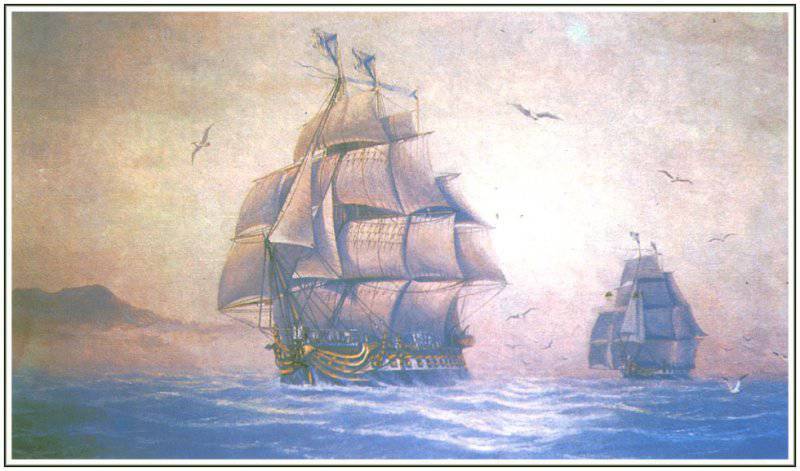
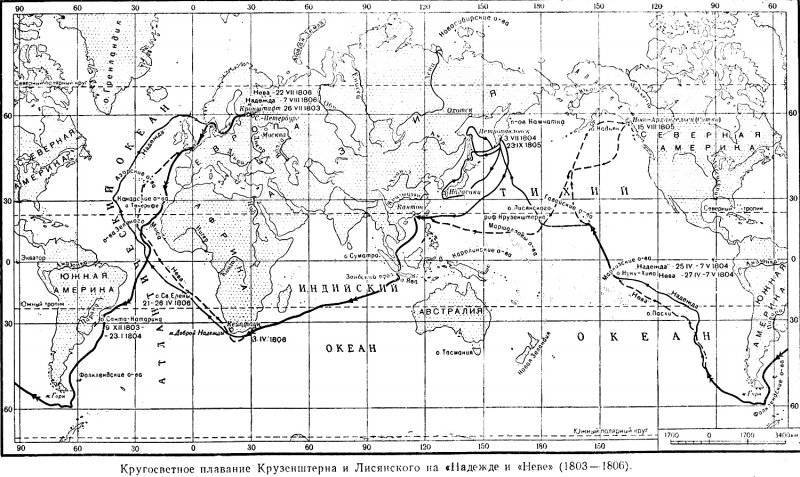
Information